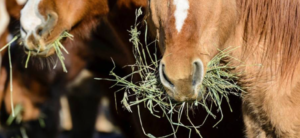 Steaming Hay One Component of Managing Equine Asthma: According to one recent study*, steaming hay, a common strategy for managing horses suffering severe equine asthma, may not help relieve the clinical signs of asthma in all horses.
Steaming Hay One Component of Managing Equine Asthma: According to one recent study*, steaming hay, a common strategy for managing horses suffering severe equine asthma, may not help relieve the clinical signs of asthma in all horses.
“Strategies such as soaking or steaming hay, housing asthmatic horses outdoors, and other allergen-avoidance techniques, in addition to medications recommended by veterinarians, are important means of managing this condition,” explained Kathleen Crandell, Ph.D., a Kentucky Equine Research nutritionist.
Management:
Crandell uses the term “management,” as there is no cure for this progressive and potentially debilitating condition. The underlying mechanics of equine asthma remain unclear, as researchers are still unsure which pro-inflammatory cytokines contribute to the condition. Is it interleukin 1β, a classic fall guy for most bodily inflammation, or interleukin 5, the inflammatory mediator currently being examined to create an “asthma vaccine”? Are other cells or mediators involved?
Past studies suggest that soaking hay lowers dust and molds. However, vitamin and mineral content might be negatively affected. Steaming hay, on the other hand, preserves the protein and mineral content of the hay with the effective reduction of respirable particles.
To determine the effectiveness of steaming hay, French veterinary researchers Orard and colleagues recruited horses with and without severe equine asthma. Both groups were offered steamed and dry hay for 5 days, with a 26-day washout period between the trials. All horses underwent assessment for their asthma clinical score, tracheal mucus accumulation, bronchoalveolar lavage fluid analysis (a “lung wash”), and mRNA expression of various inflammatory mediators.
Effectiveness of Steaming Hay:
Feeding steamed hay significantly decreased the mold content, as expected, and mucus score significantly increased when feeding dry hay. However, the clinical score of equine asthma found no significant influence.
“Above all, this goes to show that no single method will alleviate clinical signs in all horses,” Crandell said. “Managing a horse with equine asthma often requires multiple adjustments, which can include steaming hay. Not all horses in this study showed improvements. However, many horse owners have successfully used this tactic to help their horses breathe easier.”
As a result, the researchers concluded, “Steaming significantly decreased mold content but inconsistently influenced the respiratory response of sEA [severe equine asthma] affected horses when fed hay. Based on lavage fluid analysis cytology and cytokine profiles, its relevance might be controversial as a non-medicinal therapy for sEA-affected horses.”
The authors of the recently revised Consensus Statement on Equine Asthma** advise that any method of decreasing environmental exposure to known allergens like mold and dust from hay may help. In addition, they also recommend using omega-3 fatty acids to facilitate the management of equine asthma.
“Kentucky Equine Research offers EO-3, which contains 9,450 mg of marine-derived omega-3 fatty acids per serving, including DHA and EPA. This product is top-dressed onto the feed to support horses with equine asthma,” Crandell said.
In conclusion, do you have questions about Managing Equine Asthma? Contact us at J & J Hay Farms by clicking here!
Resources:
*Orard, M., E. Hue, A. Couroucé, et al. The influence of hay steaming on clinical signs and airway immune response in severe asthmatic horses. BMC Veterinary Research. In press.
**Couëtil, L.L., J.M. Cardwell, V. Gerber, et al. 2016. Inflammatory airway disease of horses—Revised consensus statement. Journal of Veterinary Internal Medicine. 30(2):503-515.

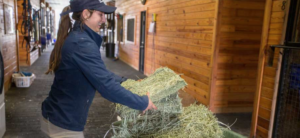 How Much Hay To Feed Horses: Where To Begin. Horses thrive on diets rife with forages, whether it is a medley of pasture grasses, baled hay, or another forage product, such as hay cubes, hay pellets, or haylage. They are capable of processing huge quantities of forage to meet their nutritional demands, but where does a horse owner start in determining how much forage to feed?
How Much Hay To Feed Horses: Where To Begin. Horses thrive on diets rife with forages, whether it is a medley of pasture grasses, baled hay, or another forage product, such as hay cubes, hay pellets, or haylage. They are capable of processing huge quantities of forage to meet their nutritional demands, but where does a horse owner start in determining how much forage to feed? Electrolytes and Muscle Function: What’s the Connection? Electrolytes are necessary for normal muscle contraction and relaxation. “When electrolytes become depleted or imbalanced, fatigue and muscle cramps can result,” says Catherine Whitehouse, M.S., a nutritionist with Kentucky Equine Research (KER).
Electrolytes and Muscle Function: What’s the Connection? Electrolytes are necessary for normal muscle contraction and relaxation. “When electrolytes become depleted or imbalanced, fatigue and muscle cramps can result,” says Catherine Whitehouse, M.S., a nutritionist with Kentucky Equine Research (KER).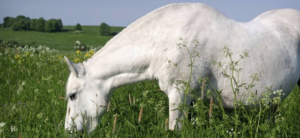 Starch and Inflammation: Considerations for Old and Overweight Horses. Body-wide inflammation contributes to the development of acute and chronic diseases in horses such as laminitis or metabolic syndrome. High-starch meals appear to induce inflammatory responses in certain young, old, and overweight horses. However, at differing time points and severities.
Starch and Inflammation: Considerations for Old and Overweight Horses. Body-wide inflammation contributes to the development of acute and chronic diseases in horses such as laminitis or metabolic syndrome. High-starch meals appear to induce inflammatory responses in certain young, old, and overweight horses. However, at differing time points and severities.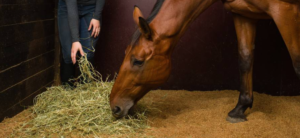 Hay for Horses: A Question of Quality. Ask horse owners to describe a perfect flake of hay, and the diversity of responses may astonish. The owner of a plus-size pony may mention a blend of local pasture grasses, sweet-smelling and pillowy to the touch; another might specify densely packed alfalfa, bright green and laden with leaves. A third owner may extol the nutritional virtues of early-maturing timothy, with its long blades and barely-there seed heads.
Hay for Horses: A Question of Quality. Ask horse owners to describe a perfect flake of hay, and the diversity of responses may astonish. The owner of a plus-size pony may mention a blend of local pasture grasses, sweet-smelling and pillowy to the touch; another might specify densely packed alfalfa, bright green and laden with leaves. A third owner may extol the nutritional virtues of early-maturing timothy, with its long blades and barely-there seed heads.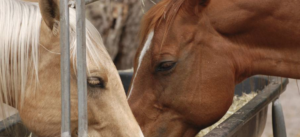
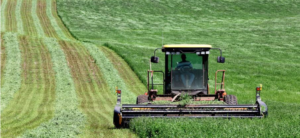 Rhizoma Peanut Hay for Horses: When horsemen think of legume hay, alfalfa invariably springs to mind with clover or lespedeza as possible runners-up. Few people probably think of rhizoma peanut (Arachis glabrata Benth), a warm-season perennial legume. While rhizoma peanut gets high marks for productivity and persistence in varying management and environmental conditions, how does it stack up nutritionally against alfalfa, the long-revered gold standard of legumes for horses?
Rhizoma Peanut Hay for Horses: When horsemen think of legume hay, alfalfa invariably springs to mind with clover or lespedeza as possible runners-up. Few people probably think of rhizoma peanut (Arachis glabrata Benth), a warm-season perennial legume. While rhizoma peanut gets high marks for productivity and persistence in varying management and environmental conditions, how does it stack up nutritionally against alfalfa, the long-revered gold standard of legumes for horses?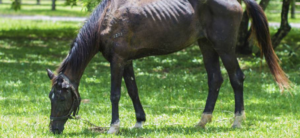 Refeeding the Starved Horse: Horses, like other animals, use the food they eat to meet the requirements of growth and maintenance. Horses eat enough grass, hay, and grain to provide plenty of energy for body functions as well as whatever exercise they are required to perform under normal circumstances. They can sustain most functions for some time when low levels of feed are available. However, weight loss may result as stored fat is burned. As the period of low or no feed is extended, they utilize protein (tissue from muscles, heart, and gastrointestinal tract) for energy. It is this burning of protein and resultant loss of body mass that differentiates a starved horse from one that is merely low on calories for a short period.
Refeeding the Starved Horse: Horses, like other animals, use the food they eat to meet the requirements of growth and maintenance. Horses eat enough grass, hay, and grain to provide plenty of energy for body functions as well as whatever exercise they are required to perform under normal circumstances. They can sustain most functions for some time when low levels of feed are available. However, weight loss may result as stored fat is burned. As the period of low or no feed is extended, they utilize protein (tissue from muscles, heart, and gastrointestinal tract) for energy. It is this burning of protein and resultant loss of body mass that differentiates a starved horse from one that is merely low on calories for a short period.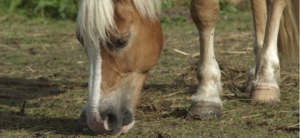 Mudbound: Feeding Horses in Muddy Pastures. When it comes to horse care, mud makes everything harder. How can horse owners deal with sloppy mud and still provide wholesome meals to their horses?
Mudbound: Feeding Horses in Muddy Pastures. When it comes to horse care, mud makes everything harder. How can horse owners deal with sloppy mud and still provide wholesome meals to their horses?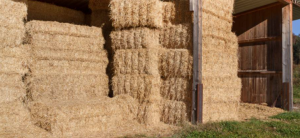 First-Cutting Hay for Horses: Buy or Bypass? Some horse owners snub first-cutting hay for horses, regardless of whether it is grass or legume. Why, you ask? Reasons abound.
First-Cutting Hay for Horses: Buy or Bypass? Some horse owners snub first-cutting hay for horses, regardless of whether it is grass or legume. Why, you ask? Reasons abound.